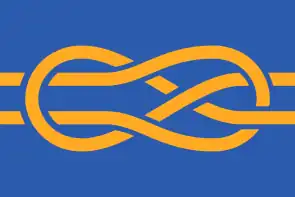Vexillology
Vexillology (/ˌvɛksɪˈlɒlədʒi/ VEK-sil-OL-ə-jee) is the study of the history, symbolism and usage of flags or, by extension, any interest in flags in general.[1]

A person who studies flags is a vexillologist, one who designs flags is a vexillographer, and the art of designing flags is called vexillography. One who is a hobbyist or general admirer of flags is a vexillophile.
History
American scholar Whitney Smith is acknowledged as conceiving the term "vexillology" in 1957. He wrote "while the use of flags goes back to the earliest days of human civilization, the study of that usage in a serious fashion is so recent that the term for it did not appear in print until 1959."[2][3] Before this time, the study of flags was generally considered a part of heraldry, the study of armorial bearings.[4] The word is a synthesis of the Latin word vexillum (which refers to a kind of square flag which was carried by Roman cavalry)[5] and the Greek suffix -logia ("study").
Vexillology was formalized by American scholar Smith in 1961 with the publication of The Flag Bulletin.[6] During his lifetime, Smith organized various flag organizations and meetings including the first International Congress of Vexillology (ICV), the North American Vexillological Association, and the International Federation of Vexillological Associations (FIAV).[7]
Involvement in vexillology includes academic work in fields such as sociology, history, or design. It also includes contributions from the flag industry and interest from those passionate about flags. The ICV and local vexillological meetings often cover a wide range of interests in flags. Since 1969, an International Congress of Vexillology meeting has been organized every two years under the auspices of FIAV; papers presented at an ICV are published afterwards as the Congress's Proceedings.[6]
In more modern times, involvement in vexillology has become less popular but is more accessible due to many internet forums and communities. One of the most notable examples is r/vexillology,[8] a community on Reddit dedicated to the subject, which has popularized vexillology to younger generations.
Vexillological organizations
The International Federation of Vexillological Associations (FIAV) is considered an international body of Vexillology. FIAV has members, including the North American Vexillological Association (NAVA), Deutsche Gesellschaft für Flaggenkunde (English: 'German Society for Flag Studies'), and Flags of the World (FOTW).[9]
See also
References
- Smith, Whitney. Flags Through the Ages and Across the World New York: McGraw-Hill, 1975. Print.
- "Vexillology". www.crwflags.com. Archived from the original on 2016-10-24. Retrieved 2017-11-03.
- "Vexillology". Merriam-Webster Online Dictionary. Archived from the original on 17 September 2020. Retrieved 15 September 2020.
- Fox-Davies, Arthur Charles (1909). A Complete Guide to Heraldry. London, Edinburgh: T.C. & E.C. Jack. p. 1. ISBN 9781602390010. OCLC 913797670.
- "Vexillum". Merriam-Webster Online Dictionary. Archived from the original on 16 September 2020. Retrieved 15 September 2020.
- "Consider Vexillology". semioticon.com – SemiotiX. Archived from the original on 2018-04-01. Retrieved 2018-04-01.
- Vulliamy, Elsa (December 15, 2015). "Which flag is it? Take our quiz to find out". The Independent. Archived from the original on 2022-08-17. Retrieved March 13, 2016.
- "r/vexillology on reddit.com". r/vexillology. Archived from the original on 2023-04-03. Retrieved 2022-03-17.
- "Current Members". International Federation of Vexillological Associations. 2022-10-16. Archived from the original on 2021-04-18. Retrieved 2023-02-17.
Further reading
- Leepson, Marc. Flag: An American Biography. New York: Thomas Dunne Books, 2005. ISBN 0312323093.
- Marshall, Tim. A Flag Worth Dying For: The Power and Politics of Flag. 2016. ISBN 1501168347.
External links
- Official website of the International Federation of Vexillological Associations



